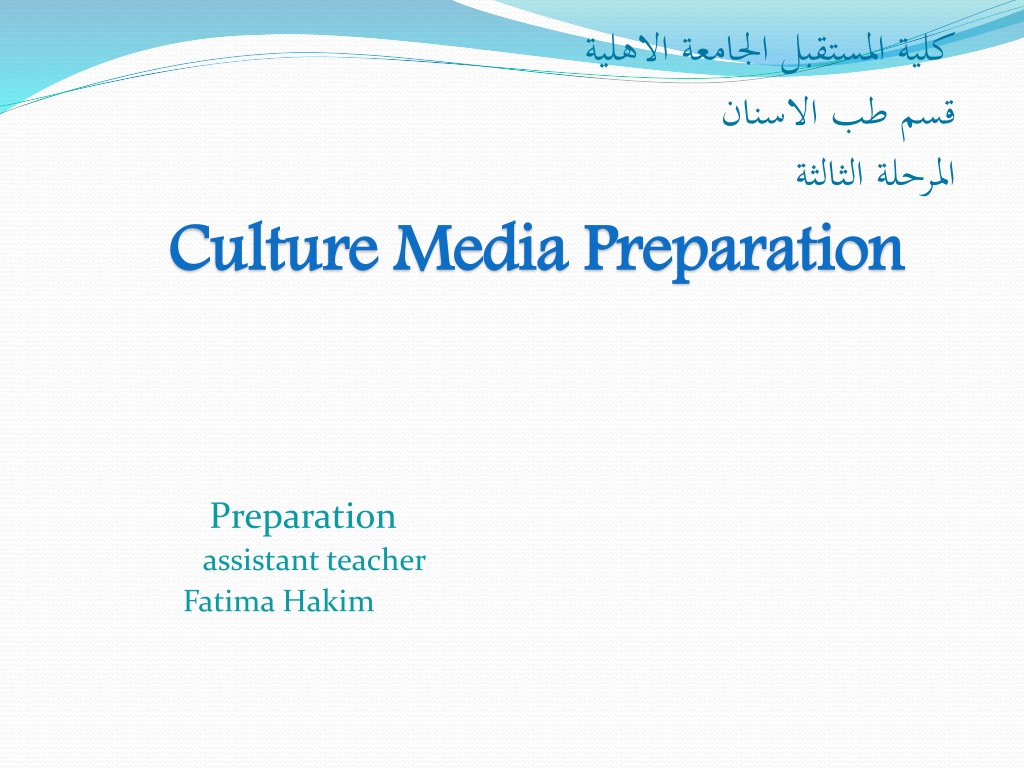
Classification of Cultures Media in Microbiology
Learn about the preparation and classification of culture media in microbiology, including basal and enriched media. Explore the different types of media used to support bacterial growth and isolate specific organisms. Discover how blood agar plates and chocolate agar are utilized in laboratory settings to cultivate and identify various bacterial species.
Download Presentation

Please find below an Image/Link to download the presentation.
The content on the website is provided AS IS for your information and personal use only. It may not be sold, licensed, or shared on other websites without obtaining consent from the author. If you encounter any issues during the download, it is possible that the publisher has removed the file from their server.
You are allowed to download the files provided on this website for personal or commercial use, subject to the condition that they are used lawfully. All files are the property of their respective owners.
The content on the website is provided AS IS for your information and personal use only. It may not be sold, licensed, or shared on other websites without obtaining consent from the author.
E N D
Presentation Transcript
Culture Media Preparation Culture Media Preparation Preparation assistant teacher Fatima Hakim
Lesson objectives Lesson objectives After 1 1- -It is known as Culture Media Preparation . 2 2- It is known as Classification of Cultures Media. After the the end end of of the the lecture, lecture, the the student student will will be be able able to to: :- -
Culture Media Preparation Culture media are artificial substances used to support bacterial growth Classification of Cultures Media
Classification of Cultures Media A A- - Basal media (Simple media - Nutrient broth or Peptone water (forms the basis of most enriched media). - Nutrient Agar a source of amino acids and nitrogen (e.g., beef, yeast extract) This is an undefined medium because the amino acid source contains a variety of compounds with the exact composition being unknown. Nutrient media contain all the elements that most bacteria need for growth kept in laboratory culture collections. Basal media (Simple media) )
B- Enriched media 1 1- -Blood Blood agar agar plate plate (BAP (BAP) ) Contains mammalian blood (usually sheep or horse), typically at a concentration of 5 10%. BAP are an enriched, differential media used to isolate fastidious organisms and detect hemolytic activity. B-hemolytic activity will show lysis and complete digestion of red blood cell contents surrounding colony. Examples include Streptococcus haemolyticus. -hemolysis will only partially lyse (the cells are either lysed or not- it is the digestion that may be incomplete) the hemoglobin and will appear green. An example of this would be Streptococcus viridans. Y-hemolysis (or non-hemolytic) is the term referring to a lack of hemolytic activity.
2 2- -Chocolate agar (CHOC) Chocolate agar (CHOC) A type of blood agar plate in which the blood cells have been lysed by heating the cells to 56 C. Chocolate agar is used for growing fastidious (fussy) respiratory bacteria, such as Haemophilus influenza. No chocolate is actually contained in the plate; it is named for the coloration only.
C- Selective media Are planned to develop growth Of a particular type of Microorganism microorganisms Examples:- Mannitol Salt Agar CCDA XLD DCA or suppress the Growth of other
D- Differential Indicator media To differentiate various kinds of microorganisms on slopes. Kligler Iron Agar (KIA) or Triple Sugar Iron Agar (TSI) To distinguish salmonella and shigella From others enterobacteraceae.
E- Selective And Differential media (Simple media) MacConky It contains bile salts (to inhibit most Gram-positive bacteria, except Enterococcus and some species of Staphylococcus i.e. Staphylococcus aureus), crystal violet dye (which also inhibits certain Gram-positive bacteria), neutral red dye (which stains microbes fermenting lactose),lactose and peptone. MacConky Agar Agar
Culture Media Preparation 1 1- - Sterilization by autoclaving: 15-20 psi at 121 C for15-20 minutes Sterilization
2 2- - Aseptically pouring agar plates Aseptically pouring agar plates
3 3- - Store of agar plates : Agar plates are stored upside down to prevent condensation. Store of agar plates : Agar plates are stored upside down to prevent condensation.
4 4- - Labeling of plates All labeling is done on the bottom of the agar plate:- Labeling of plates 1. Type of media 2. Date (mm/dd/yy) 3. Code # or letter


















